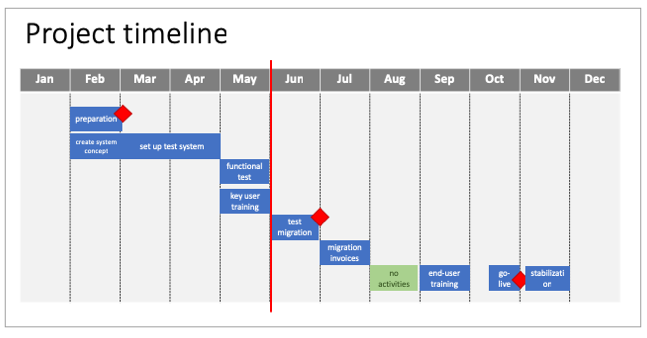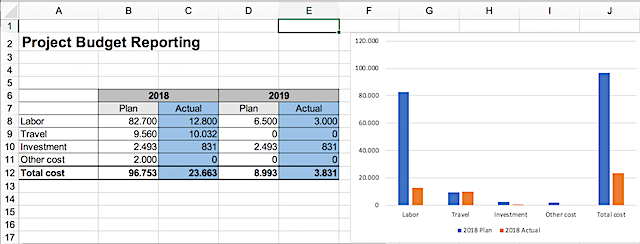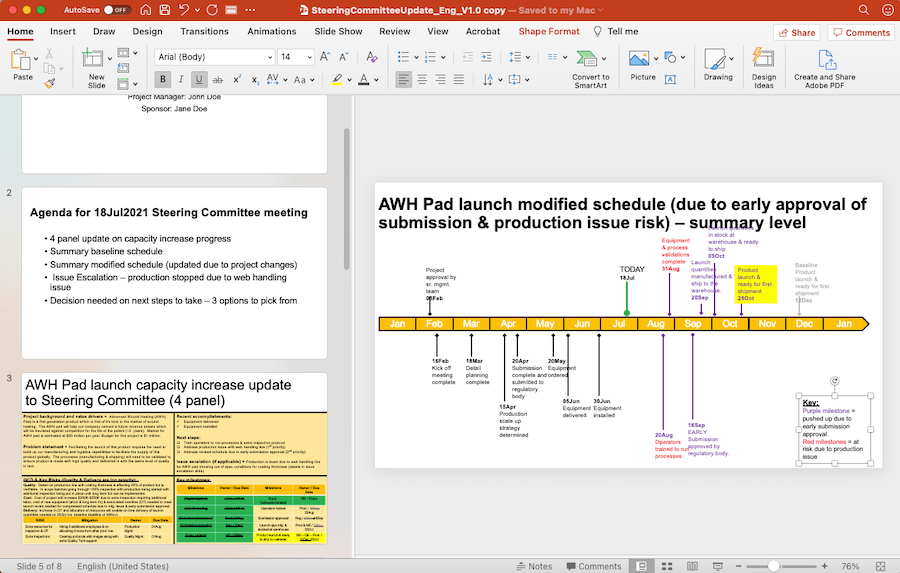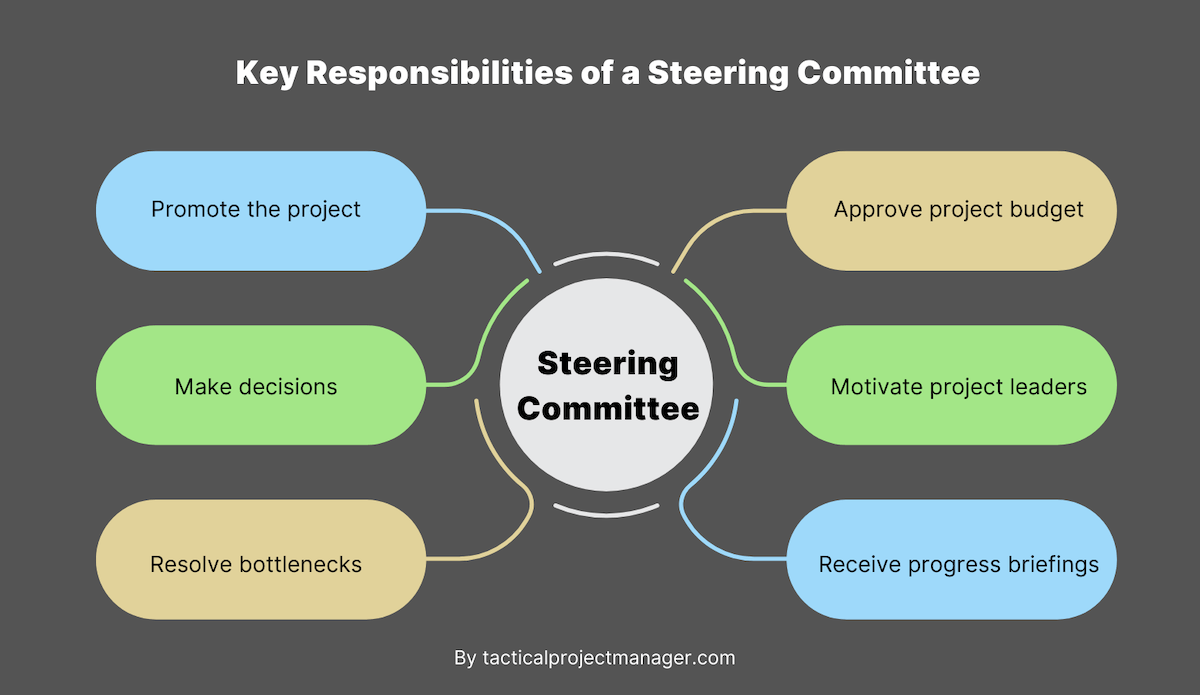Any large company initiative is loaded with “dynamite” topics like office politics, competition for resources, power struggles, and battles about the right strategic direction.
While we as project leaders can tackle many issues at our level, some issues are simply beyond our control and must be addressed from a higher level.
This is where a steering committee becomes relevant. This formal group helps oversee projects from a management perspective and ensure their success.
In this article, I’ll share everything you need to know about setting up and managing a steering committee, including what to cover during committee updates.

Key Takeaways:
- A steering committee is a group of senior leaders responsible for overseeing and guiding a project from a management level.
- Members should include high-level leaders from the main parties involved in the project. This includes the customer and sponsor and major suppliers.
- An strong steering committee will actively advocate for the project within the organization. It will also step in to address roadblocks that the project team cannot resolve on its own.
What is a steering committee?
A steering committee is a group of senior-level leaders. It is formed to oversee and support a project from management level and ensure a successful outcome.
Committee members are selected based on their stake in the project, meaning a steering committee should represent the key stakeholders.
This includes the customer, the project sponsor (who funds the project), the team contributing the most to the project, and organizational groups most affected by the project. Additionally, we should include any major suppliers providing project materials or services.
You’ll often find C-level executives like CEOs or CFOs on steering committees. Why? Projects are often the main drivers behind company strategy and involve significant spending. So it’s natural for these leaders to have an interest in a successful project.
There’s no strict rule for the size of a steering committee, but most committees I’ve worked with had between 4 and 8 members. This size was good because it allowed us to make decisions quickly and schedule meetings more easily.
Note: Steering committees are an essential element of project governance. Organizations that use a formal project management process typically require a project steering committee for projects above a certain size.
Why do projects need steering?
Think of a steering committee as parental oversight 🙂
Project teams are responsible for doing the work needed to achieve a goal. But as you’ve likely seen, many things can block progress or send a project off track.
These include resistance to change, misaligned teams, capacity bottlenecks, lack of motivation, and, of course, poor project management. The committee’s role is to step in and offer guidance and support to address these issues and prevent any further damage.
The other reason why (especially large) projects needs management oversight:
Projects often involve making important decisions that impact the organization’s operations and future direction. These decisions shouldn’t be left to the project team. They should be discussed at the management level, carefully weighing the pros and cons of each alternative.
Overall, a (strong) steering board can help resolve issues and address decisions quickly. This is when the project team has tried everything to fix a problem (without success). The committee can use its management power to solve issues and settle conflicts quickly.
What is the steering committee’s role?
So far we’ve identified two key roles of a steering committee: resolving bottlenecks and making important decisions.
But there’s more to what a steering committee does.
Here’s a complete breakdown of their responsibilities:
Responsibility #1: Promoting the project
Ever managed a bigger project? Then you know how damn hard it is to get the needed support from the people you depend on. Projects mean a ton of extra workload, stress and most importantly, change. And change is what people fear the most, especially those in positions of power.
Because projects are so unpopular, project managers often face significant pushback from stakeholders, causing delays and creating a climate that makes good collaboration hard.
This is where project managers can turn to the steering committee for help. The members are usually well-respected leaders in the organization. They can advocate for the project by highlighting its importance and encouraging team play.
Responsibility #2: Making decisions
Some decisions are too serious to be made by the project team alone. They can have broader implications for the organization or involve significant spending, so they need to be reviewed at a higher level.
These decisions, which often arise during the project, are then passed on to the committee for consideration.
Examples of important decisions:
- Buy vs. make
- Strategic direction
- Business partnership
- Cultural or organizational changes
- Process changes
- Technology investments
Responsibility #3: Help resolve bottlenecks
Real story from one of my projects:
We were in the middle of rolling out new enterprise software that we had bought from a vendor for a million dollars. However, every time we tried to install it on our servers, the software kept crashing, no matter what we did. Eventually, we decided to escalate the issue to the steering committee, who contacted the vendor for some hard talk. That got the vendor’s attention, and suddenly we were receiving priority treatment, including regular update calls with the CEO himself.
The lesson:
Reach out to your steering committee when stuck with a problem you cannot resolve yourself.
Responsibility #4: Approving the project budget
This is pretty obvious: The steering committee has to approve any transactions impacting the project budget. So if you realize in the middle of the project that you need extra equipment worth $20k, you’ll need the committee’s blessing before making the purchase.
The committee also has to approve any major change requests which involve significant changes from the original scope or budget (I hope you won’t need it that often).
Responsibility #5: Receiving progress briefings
For the steering committee to be useful, it needs to know how the project is doing. Therefore, we as project leaders should provide regular updates that offer an honest assessment of the current situation, highlight any new risks, review the budget and share an outlook on what’s coming next.
These updates also provide a great opportunity to show off our skills. A project leader who shows up confidently and appears to be in control of the project, that’s every CEO’s dream. Your next promotion may be just around the corner!
Responsibility #6: Encourage the project manager
Yes, project managers need encouragement from time to time. We have one of the toughest jobs, and expressing our emotions can provide a boost of energy.
Don’t hesitate to share how you feel; committee members are human too and can understand what you’re going through.
Before we move to the next section, read this statement by management expert Henrico Dolfing, which summarizes a steering committee’s purpose very well:
“Few steering committee members realize this, but their function is to serve as a resource for the project team — in particular the Project Manager. They need to be searching for what has to be done to ensure project success.”
Do you need a steering committee? (Yes)
From my experience I can tell you that you should absolutely set up a steering committee. Even if you are optimistic about the project, and even if you’ve been leading a lot of projects before.
A steering committe is like insurance. You only know you need it when you’re in deep trouble and need someone from management to pull you out.
A personal story:
I had been leading a number of IT projects, all of similar scope. Our projects generally went well. So we said we’d not have dedicated steering board meetings. We’d rather spend the time working on the project.
In a subsequent project things looked differently. We couldn’t get the customer to contribute in the expected manner. Deadlines were frequently missed. Every day was a struggle.
Then there was a point where we had to escalate: “Sorry, we can’t go on like this. Either we’ll make the collaboration work or we stop the project.”
What was bad: we had no forum to escalate to. No steering meeting where we could have brought up the issue. So we had to organize an ad hoc call which was a pain due to conflicting meetings.
Learn from my story.
Set up a steering committee and schedule the first couple of meetings upfront.
That takes us to the next question.
How often should the committee meet?
That depends on your project.
Generally, I recommend having one meeting every 6 – 8 weeks.
The minimum is one meeting after each project phase:
- after the project initiation phase
- after the concept phase
- after the implementation phase
- for project closure
One important point you need to understand:
If the project team faces an urgent issue, don’t wait for the next steering board meeting. The same goes for urgent decisions.
You can always reach out to the committee by email. Or schedule an ad hoc meeting.
Preparing your next steering committee meeting
Here’s what my agenda looks like:
- Progress: Where are we on the project timeline?
- Cost update: plan vs. actual cost
- Major achievements: this is where you can show how great you are
- Work in progress and next steps: What are the current tasks and next steps? Include a deadline and responsible here.
- Major issues: What issues are currently blocking the project from moving ahead?
Tip: Use the same agenda structure for every meeting.
I always start with showing the project timeline.
The red line shows where we are:

Using the same agenda format in every meeting makes it easy for the participants to follow.
I also create some extra slides for topics that need are more detailed explanation. For example, I might add a slide which includes a detailed breakdown of costs. If the steering committee asks for a more details on the cost, I just jump to this slide:

What to prepare for a decision meeting
When you are requesting a decision by the steering committee, some extra preparation is needed. A decision could be: Is the project permitted to take an extra $20K in project budget to implement a different but better solution than initially planned?
In this case you would prepare a slide giving some background:
- What is the extra budget needed for?
- What are the pro’s / con’s for going the more costly way?
- What are the implications for the project?
(Include visual elements like charts to make your point)
Once you have the slides around the decision ready, send them out to the committee members — at least 1 week before the next meeting.
By sending out the slides in advance, the committee members will have time to review the topic, have internal discussions and prepare themselves for the decision. You can’t expect the committee to make a decision ad hoc without sufficient leadtime.
In general it is not required to distribute your slides ahead of a meeting. I only do so in case there’s a decision to be taken. I would recommend you discuss with your steering committee their needs for preparation and communication.
What happens in a steering committee meeting
First you need someone leading through the meeting.
That’s usually the project manager.
That’s you.
Start by welcoming everyone. If you have guests on the meeting, let them say a few words about themselves.
Then, go though your slides:
- Project plan (progress update)
- Cost update
- Major achievements
- Work in progress and next steps
- Major issues
Thank god you won’t be the only one talking.
Committee members also want to talk.
To show they are committed and not just thinking about their next golf tournament.
So, prepare yourself for questions: Do the costs include shipping? Did you talk to HR about this? Why didn’t you do it that way? Whatever you share, be succinct and only proceed once the point has been clarified.
For cases when there’s a decision to be taken, you’ll say a few words about the topic and the committee will announce their verdict.
Don’t forget the minutes!
 Everything that’s being discussed and decided should be put into the minutes. You’ll be busy leading the meeting. Therefore have someone else write the minutes for you. The project assistant or a committee member (usually the one of lowest rank).
Everything that’s being discussed and decided should be put into the minutes. You’ll be busy leading the meeting. Therefore have someone else write the minutes for you. The project assistant or a committee member (usually the one of lowest rank).
Read my tips on taking meeting notes (as a host).
What happens after each meeting
You’ll close the meeting by thanking everyone for their participation.
Afterwards, share the meeting minutes with the conference participants and go back to work.
Do’s and don’ts for running steering meetings
My first meetings didn’t go that well. But over time I got to enjoy presenting my projects to the big guys. Here’s what I learned about running a successful steering board meeting:
Take enough time to prepare. Especially creating a set of compelling slides takes time. And the slide content often has to be reconciled with other project parties, which also takes time.
Management cares about two things only: progress and cost
They want to know:
Are we still within budget? and Is the project moving forward?
They don’t care about how many hours you worked last night. And they don’t care about how much fun you had on the last team building event.
So, focus on what’s relevant and always ask yourself:
“Why would the committee care about this?”
Then we have to talk about honesty and accuracy. Sure, you are free to choose how you present an issue. But always be honest and accurate. Never hide the facts, as they will anyway emerge sooner or later. This includes your own failures. If there’s something you know you could have done better, be open about it. You never want to loose the trust of the steering committee.
Some more things to consider
Make sure you also take care about the small stuff:
- Reserving an appropriately-sized room
- Scheduling committee meetings long in advance
- Checking the beamer – computer connection
- Familiarizing yourself with the phone so you know how to set up conference calls
- Making sure outside guests know how to reach the conference room (refer them to your assistant
8-page Powerpoint deck
Do you want to get a sample Powerpoint deck to prepare for your first Steering Committee Update?
- 8-page Powerpoint deck for a steering committee update
- featuring a real-world project
- including project summary, status update, milestone report, decisions needed and issue escalation

Author
-
Hi, I’m Adrian, a Senior Project Manager and the Creator of Tactical Project Manager, where I teach a pragmatic approach to project management. Led large-scale IT and business projects for over 10 years. My goal is to enable you to lead any project with confidence.
View all posts




